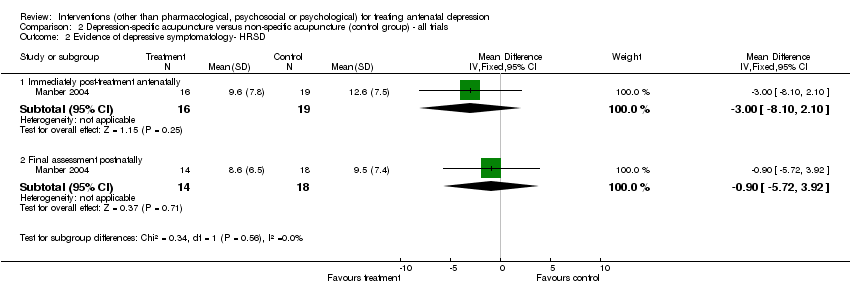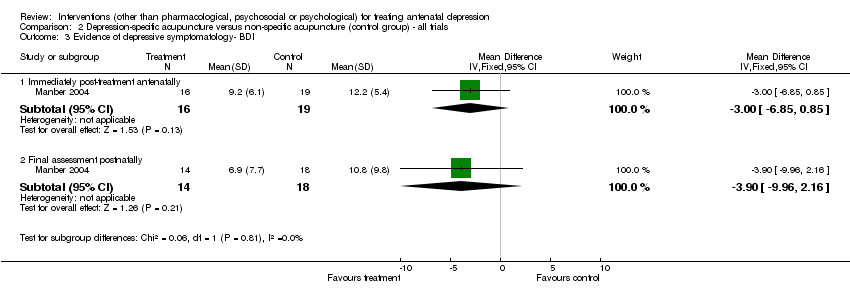Interventions (autres que pharmacologiques, psychosociales ou psychologiques) pour le traitement de la dépression prénatale
References
References to studies included in this review
References to studies excluded from this review
References to studies awaiting assessment
Additional references
Characteristics of studies
Characteristics of included studies [ordered by study ID]
Jump to:
| Methods | RCT. Modified intention‐to‐treat analysis ‐ included only participants with one post‐randomisation evaluation; data were not collected from treatment drop‐outs. | |
| Participants | 61 depressed pregnant US women; 54 women provided data for analyses. | |
| Interventions | Intervention group (depression‐specific acupuncture; n = 20): 12 25‐ to 30‐minute active acupuncture sessions by an acupuncturist following the principles of traditional Chinese medicine over an 8‐week period. Treatment specifically addressed depressive symptoms. | |
| Outcomes | Depression (immediately post‐treatment and postnatally). | |
| Notes | Small, homogenous sample. | |
| Risk of bias | ||
| Bias | Authors' judgement | Support for judgement |
| Allocation concealment? | Unclear risk | B ‐ Unclear |
| Blinding? | Low risk | |
| Incomplete outcome data addressed? | Low risk | |
BDI: Beck Depression Inventory
DSM: Diagnostic and Statistical Manual for Mental Disorders
HRSD: Hamilton Rating Scale for Depression
MDD: Major depressive disorder
RCT: randomised controlled trial
Characteristics of excluded studies [ordered by study ID]
Jump to:
| Study | Reason for exclusion |
| Not an RCT; a pilot study. | |
| Inadequate randomisation with allocation and concealment strategy not described; small sample sizes (n = 28 experimental group); standard deviations not reported. | |
| Trial designed to prevent postpartum depression. |
RCT: randomised controlled trial
Data and analyses
| Outcome or subgroup title | No. of studies | No. of participants | Statistical method | Effect size |
| 1 Evidence of clinical depression Show forest plot | 1 | Risk Ratio (M‐H, Fixed, 95% CI) | Subtotals only | |
| Analysis 1.1  Comparison 1 Massage versus non‐specific acupuncture (control group) ‐ all trials, Outcome 1 Evidence of clinical depression. | ||||
| 1.1 Immediately post‐treatment antenatally | 1 | 38 | Risk Ratio (M‐H, Fixed, 95% CI) | 0.8 [0.25, 2.53] |
| 1.2 Final assessment postnatally | 1 | 32 | Risk Ratio (M‐H, Fixed, 95% CI) | 1.93 [0.37, 10.01] |
| 2 Evidence of depressive symptomatology ‐ HRSD Show forest plot | 1 | Mean Difference (IV, Fixed, 95% CI) | Subtotals only | |
| Analysis 1.2  Comparison 1 Massage versus non‐specific acupuncture (control group) ‐ all trials, Outcome 2 Evidence of depressive symptomatology ‐ HRSD. | ||||
| 2.1 Immediately post‐treatment antenatally | 1 | 38 | Mean Difference (IV, Fixed, 95% CI) | ‐2.30 [‐6.51, 1.91] |
| 2.2 Final assessment postnatally | 1 | 33 | Mean Difference (IV, Fixed, 95% CI) | ‐0.20 [‐4.91, 4.51] |
| 3 Evidence of depressive symptomatology‐ BDI Show forest plot | 1 | Mean Difference (IV, Fixed, 95% CI) | Subtotals only | |
| Analysis 1.3  Comparison 1 Massage versus non‐specific acupuncture (control group) ‐ all trials, Outcome 3 Evidence of depressive symptomatology‐ BDI. | ||||
| 3.1 Immediately post‐treatment antenatally | 1 | 38 | Mean Difference (IV, Fixed, 95% CI) | ‐2.20 [‐5.22, 0.82] |
| 3.2 Final assessment postnatally | 1 | 33 | Mean Difference (IV, Fixed, 95% CI) | ‐0.60 [‐6.23, 5.03] |
| Outcome or subgroup title | No. of studies | No. of participants | Statistical method | Effect size |
| 1 Evidence of clinical depression Show forest plot | 1 | Risk Ratio (M‐H, Fixed, 95% CI) | Subtotals only | |
| Analysis 2.1  Comparison 2 Depression‐specific acupuncture versus non‐specific acupuncture (control group) ‐ all trials, Outcome 1 Evidence of clinical depression. | ||||
| 1.1 Immediately post‐treatment antenatally | 1 | 35 | Risk Ratio (M‐H, Fixed, 95% CI) | 0.48 [0.11, 2.13] |
| 1.2 Final assessment postnatally | 1 | 32 | Risk Ratio (M‐H, Fixed, 95% CI) | 0.64 [0.06, 6.39] |
| 2 Evidence of depressive symptomatology‐ HRSD Show forest plot | 1 | Mean Difference (IV, Fixed, 95% CI) | Subtotals only | |
| Analysis 2.2  Comparison 2 Depression‐specific acupuncture versus non‐specific acupuncture (control group) ‐ all trials, Outcome 2 Evidence of depressive symptomatology‐ HRSD. | ||||
| 2.1 Immediately post‐treatment antenatally | 1 | 35 | Mean Difference (IV, Fixed, 95% CI) | ‐3.0 [‐8.10, 2.10] |
| 2.2 Final assessment postnatally | 1 | 32 | Mean Difference (IV, Fixed, 95% CI) | ‐0.90 [‐5.72, 3.92] |
| 3 Evidence of depressive symptomatology‐ BDI Show forest plot | 1 | Mean Difference (IV, Fixed, 95% CI) | Subtotals only | |
| Analysis 2.3  Comparison 2 Depression‐specific acupuncture versus non‐specific acupuncture (control group) ‐ all trials, Outcome 3 Evidence of depressive symptomatology‐ BDI. | ||||
| 3.1 Immediately post‐treatment antenatally | 1 | 35 | Mean Difference (IV, Fixed, 95% CI) | ‐3.0 [‐6.85, 0.85] |
| 3.2 Final assessment postnatally | 1 | 32 | Mean Difference (IV, Fixed, 95% CI) | ‐3.90 [‐9.96, 2.16] |

Comparison 1 Massage versus non‐specific acupuncture (control group) ‐ all trials, Outcome 1 Evidence of clinical depression.

Comparison 1 Massage versus non‐specific acupuncture (control group) ‐ all trials, Outcome 2 Evidence of depressive symptomatology ‐ HRSD.

Comparison 1 Massage versus non‐specific acupuncture (control group) ‐ all trials, Outcome 3 Evidence of depressive symptomatology‐ BDI.

Comparison 2 Depression‐specific acupuncture versus non‐specific acupuncture (control group) ‐ all trials, Outcome 1 Evidence of clinical depression.

Comparison 2 Depression‐specific acupuncture versus non‐specific acupuncture (control group) ‐ all trials, Outcome 2 Evidence of depressive symptomatology‐ HRSD.

Comparison 2 Depression‐specific acupuncture versus non‐specific acupuncture (control group) ‐ all trials, Outcome 3 Evidence of depressive symptomatology‐ BDI.
| Outcome or subgroup title | No. of studies | No. of participants | Statistical method | Effect size |
| 1 Evidence of clinical depression Show forest plot | 1 | Risk Ratio (M‐H, Fixed, 95% CI) | Subtotals only | |
| 1.1 Immediately post‐treatment antenatally | 1 | 38 | Risk Ratio (M‐H, Fixed, 95% CI) | 0.8 [0.25, 2.53] |
| 1.2 Final assessment postnatally | 1 | 32 | Risk Ratio (M‐H, Fixed, 95% CI) | 1.93 [0.37, 10.01] |
| 2 Evidence of depressive symptomatology ‐ HRSD Show forest plot | 1 | Mean Difference (IV, Fixed, 95% CI) | Subtotals only | |
| 2.1 Immediately post‐treatment antenatally | 1 | 38 | Mean Difference (IV, Fixed, 95% CI) | ‐2.30 [‐6.51, 1.91] |
| 2.2 Final assessment postnatally | 1 | 33 | Mean Difference (IV, Fixed, 95% CI) | ‐0.20 [‐4.91, 4.51] |
| 3 Evidence of depressive symptomatology‐ BDI Show forest plot | 1 | Mean Difference (IV, Fixed, 95% CI) | Subtotals only | |
| 3.1 Immediately post‐treatment antenatally | 1 | 38 | Mean Difference (IV, Fixed, 95% CI) | ‐2.20 [‐5.22, 0.82] |
| 3.2 Final assessment postnatally | 1 | 33 | Mean Difference (IV, Fixed, 95% CI) | ‐0.60 [‐6.23, 5.03] |
| Outcome or subgroup title | No. of studies | No. of participants | Statistical method | Effect size |
| 1 Evidence of clinical depression Show forest plot | 1 | Risk Ratio (M‐H, Fixed, 95% CI) | Subtotals only | |
| 1.1 Immediately post‐treatment antenatally | 1 | 35 | Risk Ratio (M‐H, Fixed, 95% CI) | 0.48 [0.11, 2.13] |
| 1.2 Final assessment postnatally | 1 | 32 | Risk Ratio (M‐H, Fixed, 95% CI) | 0.64 [0.06, 6.39] |
| 2 Evidence of depressive symptomatology‐ HRSD Show forest plot | 1 | Mean Difference (IV, Fixed, 95% CI) | Subtotals only | |
| 2.1 Immediately post‐treatment antenatally | 1 | 35 | Mean Difference (IV, Fixed, 95% CI) | ‐3.0 [‐8.10, 2.10] |
| 2.2 Final assessment postnatally | 1 | 32 | Mean Difference (IV, Fixed, 95% CI) | ‐0.90 [‐5.72, 3.92] |
| 3 Evidence of depressive symptomatology‐ BDI Show forest plot | 1 | Mean Difference (IV, Fixed, 95% CI) | Subtotals only | |
| 3.1 Immediately post‐treatment antenatally | 1 | 35 | Mean Difference (IV, Fixed, 95% CI) | ‐3.0 [‐6.85, 0.85] |
| 3.2 Final assessment postnatally | 1 | 32 | Mean Difference (IV, Fixed, 95% CI) | ‐3.90 [‐9.96, 2.16] |

